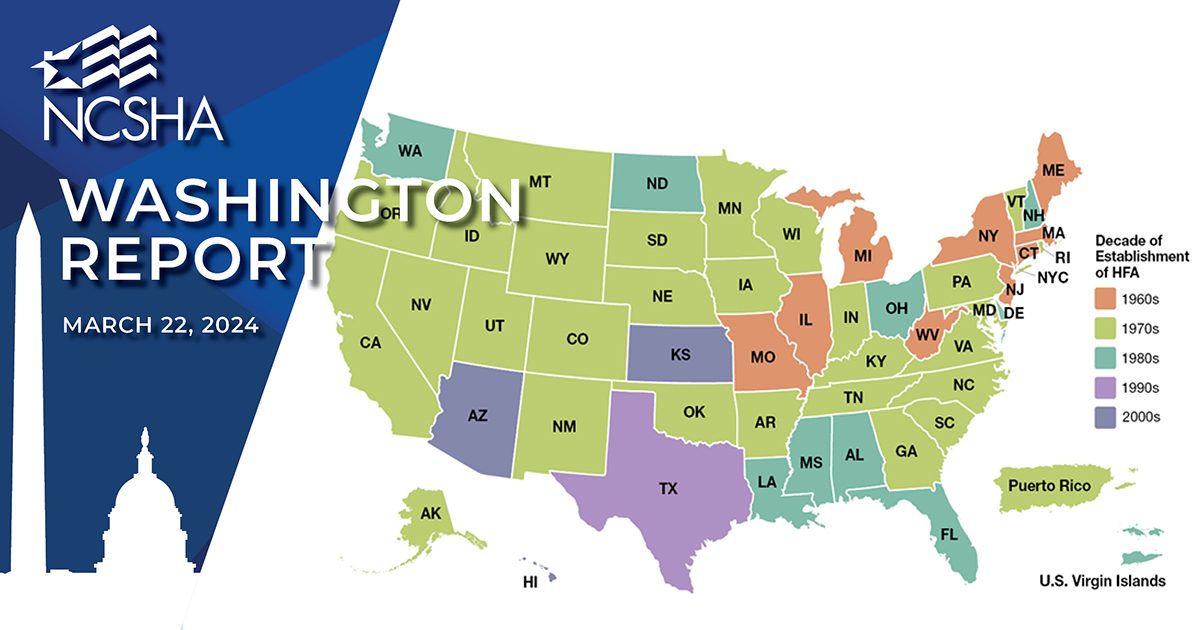NCSHA Washington Report | March 22, 2024

Housing finance agencies have always acted as “gap fillers”: providers of the necessary capital to fund the difference between what it costs — under current conditions — to buy or build an affordable home and what low-income people can reasonably pay to own or rent one.
With virtually every major cost input into building and owning — for sale or rental — sharply higher in recent years, HFAs are playing that role more than ever and putting unprecedented amounts of additional funding into projects and properties struggling under extraordinary economic stress.
At the same time, HFAs are making a number of new moves to help reduce housing costs.
Starting with land and improvements. While infrastructure-funding “impact fees” affect home prices in various ways, “in some places the cost of the fee or exaction may necessitate a reduction in land prices or an increase in rents or home prices that go beyond what developers believe the market will bear,” according to the Local Housing Solutions research network.
HFAs in Georgia and Wisconsin are defraying the costs of water, sewer, and street improvements for new affordable home construction necessary for economic development. Michigan last year created two new tools to fund infrastructure and site preparation costs for for-sale and rental housing development. In Minnesota, an innovative HFA program has funded land acquisition for home building by community land trusts.
In other states, such as Maine and Oklahoma, HFAs are funding a share of builders’ direct construction costs for entry-level homes, a meaningful incentive at a time when construction financing remains “challenging” for many. More than a dozen HFAs are offering some form of construction assistance to support single-family home building, according to NCSHA survey data.
Some agencies are investing in off-site construction in search of scalable cost-saving approaches in development, for both single- and multifamily homes. Off-site construction’s potential as an affordable production breakthrough has been occasionally oversold, and the sector has seen a few high-profile failures. Nevertheless, projects are coming on line around the country, some funded by HFAs, and new entrants such as Vessel Technologies see the agencies as potential partners.
Oregon Housing and Community Services’ Modular Housing Development Fund recently put $20 million into “facility expansion, unit design standardization, equipment purchases, and technology advancement” for four companies in the state. The Colorado HFA is a lead partner in its state’s investment in eight modular housing manufacturers, which are projected to produce more than 4,750 “panelized, tiny homes, kit homes, and offsite 3D-printed homes” annually as a result.
These and other similar initiatives around the country are relatively small and somewhat experimental, but they are important. They reflect a growing sense of urgency among state housing finance agencies to do what they can to make it more affordable to produce affordable housing. Everyone in the industry should be working toward that goal.

Stockton Williams | Executive Director
In This Issue
- Neale Named Virginia Housing CEO
- Tax Bill’s Path for Advancement Narrows as Senate Negotiations Stall
- HAF Has Helped More Than 500,000 Families Stay in Their Homes, Treasury Reports
- Treasury Publishes Updated Population Figures for Housing Credit and Bonds
- House Housing Subcommittee Holds Hearing on Home Buyers’ Challenges
- Looking Ahead
Neale Named Virginia Housing CEO
This week, Virginia Housing announced Tammy Neale has been named chief executive officer, effective April 1. During her 39 years with Virginia Housing, Neale has served as strategic planning leader, managing director of human resources, managing director and chief learning officer, chief of staff, and chief of programs and has played a key role in shaping the agency’s strategic direction and implementing its vision and priorities.
Tax Bill’s Path for Advancement Narrows as Senate Negotiations Stall
The Senate’s lead tax writers, Finance Committee Chair Ron Wyden (D-OR) and Ranking Member Mike Crapo (R-ID), have not been able to strike a deal to advance the House-passed Tax Relief for American Families and Workers Act, which includes two provisions to expand Housing Credit production: reinstating a 12.5 percent cap increase that expired after 2021 and lowering the bond-financing threshold from 50 to 30 percent. While some press reports this week suggested Crapo told his colleagues at a private Republican luncheon that he does not want to pass a tax bill this year, Crapo later told reporters this was not true and he is continuing to work with Wyden on an agreement, though he acknowledged negotiations have hit an impasse for now.
If they cannot reach an agreement, Majority Leader Chuck Schumer (D-NY) could still bring the bill to the floor. Passing it would require 60 votes to overcome a filibuster, which would be far more challenging without support from Republican leadership, and Minority Leader Mitch McConnell is expected to back Crapo on whatever he decides. On Wednesday night, Schumer took a preliminary procedural step needed for eventual floor consideration by putting the bill on the Senate’s legislative calendar. This step does not necessarily mean the Senate will take it up, and Schumer is likely to do so only if he believes there is a good chance it will pass, given finite floor time and competition from other legislative business. If Wyden and Crapo cannot reach a deal, the future of the bill will depend on whether there are still enough Republicans willing to vote for it.
With the Senate scheduled to leave town on Friday for the two-week Spring recess, the soonest the bill could go to the floor is the week of April 8. There is no firm deadline for passing the bill, but it will be harder to do so the farther out it gets from the April 15 end of the tax filing season and the closer it gets to the height of election campaign season.
HAF Has Helped More Than 500,000 Families Stay in Their Homes, Treasury Reports
The Homeowner Assistance Fund (HAF) has provided $6.6 billion in assistance to more than a half million struggling homeowners through 2023, the Treasury Department announced earlier this week. This represents a nine percent increase over the third quarter of 2023. Treasury credits HAF agencies with assisting vulnerable and underserved households, noting 54 percent of approved HAF applications were for very low-income homeowners. In addition, 40 percent of HAF beneficiaries identified as Black and 20 percent as Latino. In its results summary, Treasury highlighted recent efforts by the South Carolina State Housing Finance and Development Authority, Indiana Housing and Community Development Authority, and New Hampshire Housing to make it easier for homeowners to access their HAF programs. Treasury released a spreadsheet containing details on HAF program activities and a blog post about how Treasury and HAF administrators applied lessons learned from the Hardest Hit Fund in the design and implementation of their HAF programs. NCSHA summarized these materials in our blog.
Treasury Publishes Updated Population Figures for Housing Credit and Bonds
On March 18, the Internal Revenue Service issued Notice 2024-25 (within Internal Revenue Bulletin 2024-12) officially advising states of the resident population figures needed to determine states’ 2024 private activity bond (PAB) volume cap and the population-based component of the Housing Credit ceiling. The per capita and small state minimum amounts were released last year in Revenue Procedure 2023-34, which set the 2024 PAB volume cap at the greater of $125 per capita or $378,230,000 and the population component of the Housing Credit ceiling at the greater of $2.90 per capita or $3,360,000.
House Housing Subcommittee Holds Hearing on Home Buyers’ Challenges
The House Housing and Insurance Subcommittee Wednesday held a hearing to consider the challenges home buyers face in today’s market. Subcommittee Chair Warren Davidson (R-OH) started the hearing by citing the rising costs of homeownership, which he said were being driven by Biden Administration policies driving up inflation. He criticized recent Biden proposals to help new home buyers, which he said would further increase costs without addressing supply, and said he hoped the hearing would allow the subcommittee to consider credible solutions to lowering homeownership costs. Subcommittee Ranking Member Emanuel Cleaver (D-MO) echoed Davidson’s concerns about the increasing costs of homeownership and said the Financial Services Committee should act to advance several bipartisan bills, including a bill he introduced with Rep. Blaine Luetkemeyer (R-MO) to reform rural housing programs. Witnesses presenting testimony were Dr. Michael Fratantoni from the Mortgage Bankers Association, Dr. Jessica Lautz from the National Association of REALTORS®, and Nikitra Bailey from the National Fair Housing Alliance.
Legislative and Regulatory Activities
- April 4 | Applications Due | HUD NOFO for Housing Counseling in Distressed Communities
- April 5 | Comments Due to NCSHA | USDA Single-Family Housing Guaranteed Loan Program Loan Servicing Policy Changes
- April 12 | Comments Due | USDA Single-Family Housing Guaranteed Loan Program Loan Servicing Policy Changes
- April 15 | Comments Due | Build America, Buy America Request for Input
NCSHA, State HFA, and Industry Events
- April 2, 2:00 – 3:00 pm ET | Tips for Preparing Your Entries in NCSHA’s 2024 Awards for Program Excellence | Webinar
Open only to NCSHA’s HFA members. - April 4 | Last Day to Register at the Early-Bird Rate | NCSHA’s Preserving Owner-Occupied Affordable Homes | April 17 Virtual Symposium
- April 15 – 17 | Nebraska Investment Finance Authority’s Innovation Expo | Lincoln, NE
Jennifer Schwartz will speak at this event. - April 17, 12:30 – 5:15 pm ET | NCSHA’s Preserving Owner-Occupied Affordable Homes | Virtual Symposium
- April 30 – May 2 | 2024 Affordable Housing Investors Council Spring Meeting | Milwaukee, WI
Garth Rieman will speak at this event. - May 1, 11:59 pm ET | Entry Deadline | NCSHA’s Annual Awards for Program Excellence
- May 1 – 2 | Pennsylvania Housing Finance Agency’s 2024 Housing Forum | Harrisburg, PA
Jennifer Schwartz will speak at this event.

